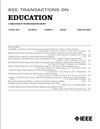利用部分翻转课堂和游戏化提高一年级电子电路课程的学生成绩
IF 2
2区 工程技术
Q2 EDUCATION, SCIENTIFIC DISCIPLINES
引用次数: 0
摘要
贡献本研究提供了部分游戏化翻转课堂的实施情况,结果表明,与传统授课相比,学生的学习成绩在统计学上有显著提高。背景:电子电路是台湾大学电子工程学位课程一年级学生的一门具有挑战性的必修课程。选修英语课程的学生成绩历来低于选修其他中文课程的学生,这可能是由于他们的背景不同,对台式考试不太熟悉。预期成果:本研究采用游戏化翻转学习教学法,评估其在提高学生解决未分级练习题的积极性和提高学生成绩方面的效果。课堂上三分之一的时间是通过补充在线视频进行的浓缩课堂讲授,三分之二的时间是学生以小组为单位进行的问题解决课程。课堂游戏板(排行榜)和每周概念卡(徽章)被用来激励学生完成每周的未评分练习题。研究结果结果显示,游戏化翻转学习法使英语组的标准化测验和考试成绩比前一年平均提高了 11.6%,使该组的平均成绩与其他组(对照组)相当。结果还发现,较高的成绩与较高的课堂问题完成率密切相关,而与课堂出勤率无关。调查结果显示,与课程游戏板相比,学生更喜欢团队合作、接收概念卡和完成挑战问题等游戏化环节。本文章由计算机程序翻译,如有差异,请以英文原文为准。
Using a Partially Flipped Classroom and Gamification to Improve Student Performance in a First-Year Electronic Circuits Course
Contribution: This study provides an implementation of a partially flipped classroom with gamification aspects that has shown a statistically significant increase in student performance relative to traditional lecture. Background: Electronic Circuits is a challenging required course for first-year students in the Electrical Engineering degree program at National Taiwan University. Students taking the English section have historically performed lower than other Chinese sections, likely due to their diverse backgrounds and less familiarity with Taiwanese-style exams. Intended Outcome: This study applied flipped-learning-with-gamification teaching methods to evaluate their effectiveness in improving students’ motivation to solve ungraded practice problems and increase student performance. One-third of the class was a condensed in-class lecture with supplemental online videos, while two-thirds was a problem-solving session with students in teams. A class gameboard (leaderboard) and weekly concept cards (badges) were used to motivate the students to complete weekly ungraded practice problems. Findings: The results showed that the flipped-learning-with-gamification approach increased the average of the English section’s normalized quiz and exam grades by 11.6% compared to the previous year, such that the section’s average performance matched that of the other sections (control groups). Results also found that higher grades were most strongly correlated with higher completion rates of in-class problems and were uncorrelated with lecture attendance. Survey results showed that students liked the gamification aspects of working in teams, receiving concept cards, and completing challenge problems more than the course gameboard.
求助全文
通过发布文献求助,成功后即可免费获取论文全文。
去求助
来源期刊

IEEE Transactions on Education
工程技术-工程:电子与电气
CiteScore
5.80
自引率
7.70%
发文量
90
审稿时长
1 months
期刊介绍:
The IEEE Transactions on Education (ToE) publishes significant and original scholarly contributions to education in electrical and electronics engineering, computer engineering, computer science, and other fields within the scope of interest of IEEE. Contributions must address discovery, integration, and/or application of knowledge in education in these fields. Articles must support contributions and assertions with compelling evidence and provide explicit, transparent descriptions of the processes through which the evidence is collected, analyzed, and interpreted. While characteristics of compelling evidence cannot be described to address every conceivable situation, generally assessment of the work being reported must go beyond student self-report and attitudinal data.
 求助内容:
求助内容: 应助结果提醒方式:
应助结果提醒方式:


